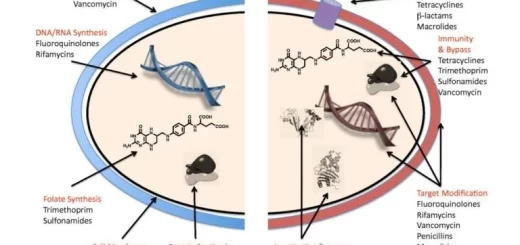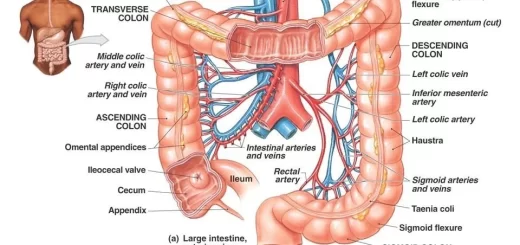Histology of the peripheral circulation, Types of capillaries and Lymphatic system
The peripheral circulation transports blood around the body, It exchanges nutrients with tissues and stores blood. peripheral circulation alters the blood distribution to meet the needs of the different tissues, The aorta is mainly an elastic structure, Peripheral arteries become more & more muscular until the arterioles, where the muscular layer predominates.
Histology of the peripheral circulation
It is the connection between arteries and veins, It includes capillaries and arteriovenous shunts.
Capillaries
Capillaries make up over 90% of the body vasculature as they anastomose extensively forming the capillary network (capillary bed), which allows the exchange of gases and metabolites between the blood tissues.
Histological structure of a blood capillary
The wall of a blood capillary is composed of a single layer of endothelial cells resting on a prominent basal lamina, which is splitted to enclose the pericytes.
The endothelial cells are joined together by occluding junctions and they are rolled up to form a tube with a diameter of about 9-12 μm i.e. large enough to allow passage of RBCs one at a time.
The pericytes:
- These are perivascular mesenchymal cells with branching cytoplasmic processes.
- They partially surround the endothelial cells of capillaries and post-capillary venules along their course.
- Pericytes are enclosed in the basal lamina of the endothelial cells.
Function:
- Support of capillaries and post-capillary venules.
- Contractile function suggested by the presence of actin filaments in their cytoplasm.
- Stem cells, as following tissue injury, pericytes proliferate and differentiate to form new endothelial and smooth muscle cells thus help in the repair process
Types of capillaries
A. Continuous capillaries
- The wall of these capillaries has no fenestrations with continuous basal lamina.
- The endothelial cells are held together by many occluding junctions with overlapping marginal folds.
- The cytoplasm is filled with numerous pinocytotic vesicles that function in the trans-endothelial transport of molecules.
- This is the most common type of capillaries and is found in muscular tissue, lung, skin, and nervous tissue.
- This type of capillaries provides well-regulated metabolic exchange and thus share in the formation of different blood barries e.g. blood-brain barrier and blood-thymus barrier.
B. Fenestrated capillaries
- The endothelial cells have numerous fenestrations (circular openings), with continuous basal lamina which covers the fenestrations.
- These fenestrations are closed by a thin non-membranous diaphragm, derived from the glycocalyx of the cell membrane.
- The endothelial cells also have numerous pinocytotic vesicles.
- This type of capillaries allows more muscular exchange between tissues and blood as in endocrine glands and intestinal villi.
C. Sinusoids (sinusoidal capillaries)
- These are thin-walled vascular channels with a relatively large caliber (30-40 μm) and irregular outline.
- The endothelial cells have large openings in their cytoplasm without diaphragms and are separated by wide intercellular gaps.
- The endothelial cells rest on a discontinuous basal lamina and are supported by delicate reticular fibers.
- Macrophages, not pericytes, are usually associated either within or around the sinusoids.
- This type of capillaries allows movement of cells and maximal exchange between tissues and blood as in bone marrow, liver, spleen.
Arteriovenous anastomoses (A-V shunts)
- The A-V shunt is a direct connection between an arteriole and a venule without passing in the capillary bed.
- Sites: skin of palm & sole, nose, lip, and erectile tissue of the penis.
- Structure: it arises as a side branch from the terminal arteriole and runs directly to a small venule. The arteriole of the A-V shunt has a relatively thick smooth muscle layer and it is richly innervated.
- Function: contraction of the smooth muscle at the arteriolar side of the A-V shunt ”close” the shunt thus sends blood to the capillary bed. Relaxation of arteriolar smooth muscles ”open” the shunt thus sends a considerable volume of blood directly into the venule and bypassing the capillary bed.
The lymphatic system
It is a drainage system that collects the excess interstitial fluid, the lymph and returns it to the blood. The lymphatic vascular system is also a major distributor of lymphocytes and other immune components carried through the lymphoid tissue. It consists of the lymph, lymph vessels, and lymphoid tissues.
A. The lymph a viscid substance formed of components of large molecular size that cannot be reabsorbed by the venous side of the blood circulation. These include:
- Protein-rich fluid is removed from the intercellular spaces.
- Lipids, that are too large to cross the fenestrations of the capillaries of the intestinal villi.
B. The lymph vessels:
– The lymphatic capillaries:
- Lymph is drained by blind-ended channels which are irregular in shape.
- They are lined by thin endothelial cells resting on an incomplete basal lamina.
- Openings between lymphatic endothelial cells are kept open by anchoring filaments that bind to surrounding connective tissue.
– Large lymphatic vessels:
- Lymphatic vessels converge to form the thoracic duct and the right lymphatic duct which empty lymph back into the blood.
- They have a structure similar to that of veins, having valves to keep the lymph flow unidirectional. However, they have thinner walls and lack a clear-cut separation between layers (intima, media, and adventitia).
Blood vessels structure, function, layers, characteristics & How blood vessels work
Anatomy of the circulatory system, Vascular system, Arteries of head and neck
Cardiovascular system, Blood pressure regulation, Heart rate & its regulation
Heart & Pericardium structure, Abnormalities & Development of the heart



